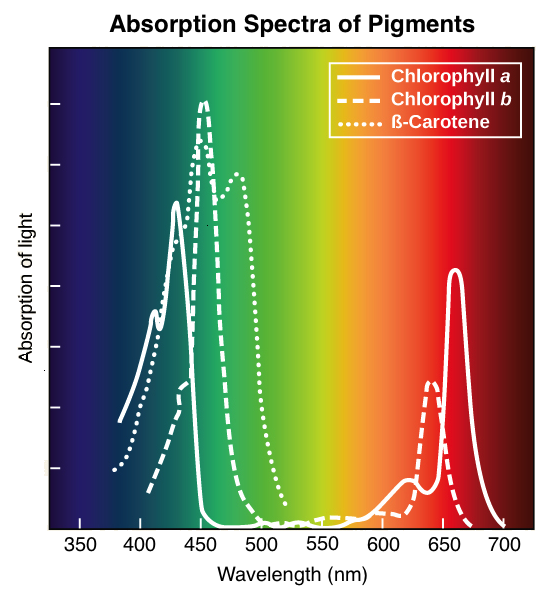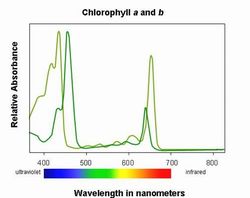The plant wont have any lightchemical energy to do photosynthesis and it will die. There once was a man.

Wavelengths Of Light And Photosynthetic Pigments Article Khan Academy
What happens to chlorophyll in the dark.

What happens to chlorophyll when plants are kept in dark. In the absence of light the production of chlorophyll-a molecules stops. When a plant is kept in a dark room it will be unable to perform photosynthesis. The plant would eventually die of starvation because a plant needs light to carry out the process of photosynthesis.
Plants are required to be kept in dark room prior to the experiment to carry out the process of destarching. Photosynthetic mechanism could adapt to a situation where saturation of photosynthc- sis would be at lower intensities. Chlorophyll smells like smelly curry.
Students can extend this basic experiment by repeating the procedure with discs taken from the white areas of leaves. Because chlorophyll reflects green light. The plants which are kept in the dark are generally yellow or pale green because the production of the chlorophyll pigment essential for photosynthesis is directly proportional to the amount of light available.
Through photosynthesis the plant uses the stored energy to convert carbon dioxide absorbed from the air and water into glucose a type of sugar. So the chlorophyll is present but by keeping the plant in the dark youre making it work harder to. Will it perform the Calvin Cycle.
The energy absorbed from light is transferred to two kinds of energy-storing molecules. The reason is that the chlorophyll pigment will be rich and enriched only when it is shown towards the sun light but while placing it in dark the chlorophyll of the plant starts degrading and the pigment will slowly begin to eradicate. Photosynthesis produces organic sugars which are stored in form of starch in plants.
Plants use glucose together with. Water Oxygen Chlorophyll Ans. When the leaves are kept in dark it will become yellow.
Chlorophyll needs light for photosynthesis. In addition they will measure the starch production in green leaves kept in the dark while floating in glucose solution. If they arent low light house plants then the leaves will fall off or they will become etoliated and the plant will eventually become weak pest prone and starve to death because it wont.
Leaves are natures food factories. When the leaves are kept in dark it will become yellow. Specific proteins associated with photosynthesis were still hanging around and genes known to be associated with senescence SAGs.
D Used up-Water Produced-Oxygen Remain Unchanged-Chlorophyll. The correct answer is option D. If its not good its probably made in the hood thats what i like to say.
The plants which are kept in the dark are generally yellow or pale green because the production of the chlorophyll pigment essential for photosynthesis is directly proportional to the amount of light available. The reason is that the chlorophyll pigment will be rich and enriched only when it is shown towards the sun light but while placing it in dark the chlorophyll of the plant starts degrading and the pigment will slowly begin to eradicate. What happens to chlorophyll when plants are kept in dark.
When the leaves are kept in dark it will become yellow. What happens to chlorophyll when plants are kept in dark. The role of photons.
The reason is that the chlorophyll pigment will be rich and enriched only when it is shown towards the sun light but while placing it in dark the chlorophyll of the plant starts degrading and the pigment will slowly begin to eradicate. The plants which are kept in the dark are generally yellow or pale green because the production of the chlorophyll pigment essential for photosynthesis is directly proportional to the amount of light available. If a plant is kept in the dark will it perform the LDRs.
Describe what happens in the mouth. What happens to chlorophyll in the dark. 4 shows the relationship between photosyn- thesis and light 43 70 and 90 hr after dark exposure.
In the rest of this post I will give you a more in-depth look at what happens when you keep a plant in a dark room and leave it there for a period of time. Amylase breaks down large starch molecules into smaller maltose molecules. Chlorophylls job in a plant is to absorb lightusually sunlight.
Inside the plant cell are small organelles called chloroplasts which store the energy of sunlight. Without photosynthesis the plant will not be able to make its own food and the plant will slowly die. The absence of photosynthesis would lead to consumption of all stored starch making the leaf starchless.
In the absence of light the production of chlorophyll-a molecules stops and they get. In the absence of light the production of chlorophyll-a molecules stops. Chlorophyll in two cultures of Dunaliella euchlora after increasing time in darkness.
Putting the plant in dark for 48 hours would stop the process of photosynthesis as light is required for it. A photosynthesise b grow taller to reach the light. A chemical called chlorophyll helps make photosynthesis happen.
This process is the plants way of making food to life off of. Within the thylakoid membranes of the chloroplast is a light-absorbing pigment called chlorophyll which is responsible for giving the plant its green color. Chewing increases the surface area of food for.
Hence when a plant is kept in dark before the experiment it is unable to perform photosynthesis and derives its energy solely from the leftover starch in the plants. If they are low light house plants and the room is not too dark then they will be fine. Chlorophyll is very important in the production of cheeses.
What happens in the chlorophyll. During photosynthesis chlorophyll absorbs energy from blue- and red-light. Answer 1 of 2.
Answer 1 of 2. After 2 or 5 days of darkness the whole plants hadnt undergone any of the normal signs of senescence. What happens to chlorophyll in the dark.
Thus no light-no. As photsynthesis splits water what happens to the hydrogen. Chlorophyll is what gives plants their green color.
Students begin by measuring starch production by green leaf discs in the dark and the light. A plant is kept in the dark for two days. They hadnt lost a lot of chlorophyll and hadnt really started mass recycling their proteins.
The process of leaves turning sunlight water and carbon dioxide into oxygen and glucose sugar is called photosynthesis. A leaf is. In the presence of light it absorbs red light and reflects green light and carries out photosynthesis.
